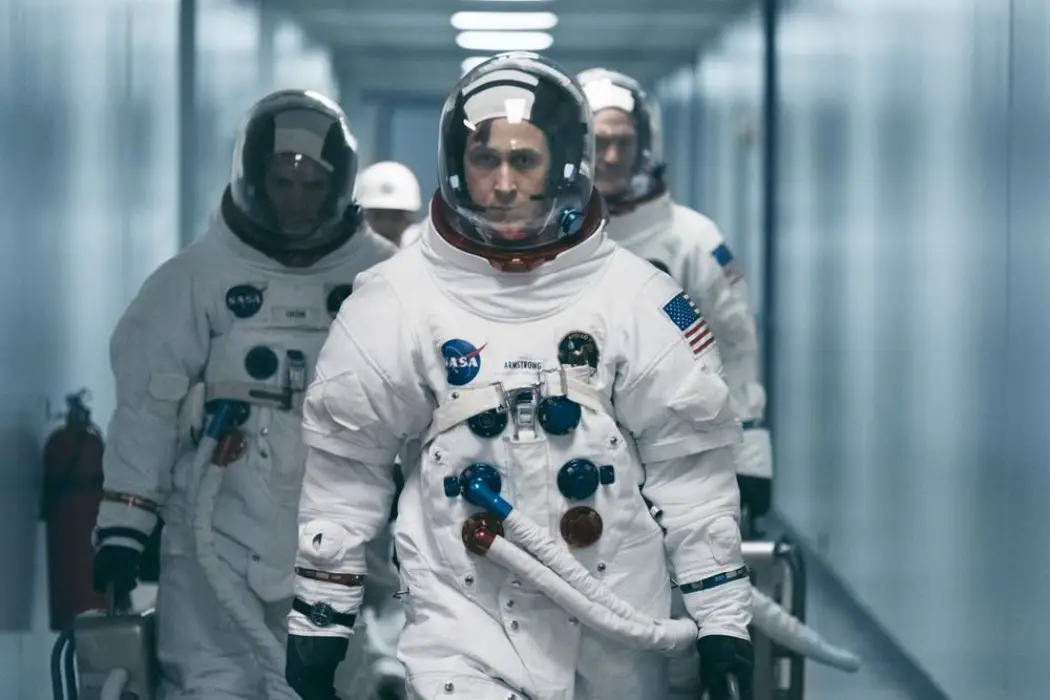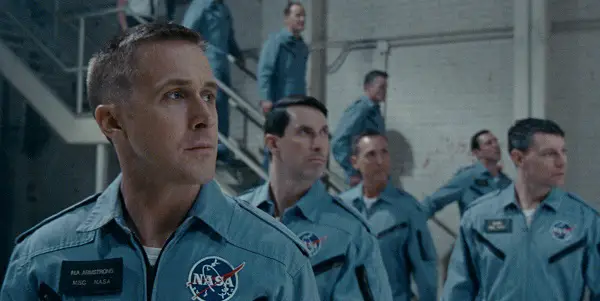FIRST MAN: Thrilling Space Adventure Is Out Of This World

Seattle area film critic and aspiring screenwriter. My reviews can…
You know that moment when your rollercoaster is about to plunge 300 feet at 100 miles per hour and realize the only thing keeping you alive is a flimsy safety harness? Now imagine the feeling of streaking seven miles per second to altitudes of over 100,000 feet with only a thin sheet of metal between you and the vacuum of space.
First Man captures that intoxicating mix of euphoria and terror in this thrilling docudrama about the successes and failures preceding the 1969 Apollo 11 Moon landing. Director Damien Chazelle’s emphasis on realism and Ryan Gosling’s understated performance take us into a world of unimaginable danger; where families can be instantly torn apart and heroes can live on for eternity. It’s a barrage of sight and sound that smothers the audience in uncertainty, even when the historical outcomes are well known.
Keeping It Real
Archival footage of astronauts cavorting on the Moon or loading into rocket c*ckpits is one thing, but creating the sensation of hurtling through space is quite another. The monumental task of strapping audiences into the capsule alongside Neil Armstrong fell to director Damien Chazelle (La La Land, Whiplash) – and he succeeds wildly. First Man is an unparalleled technical achievement that utilizes practical “in camera” effects, stomach churning sound design, and inventive modern techniques to transform the archival into the real.
Chazelle immediately sets the stage by transporting Armstrong (Gosling) back to his early days in the Space Program. It’s 1961 and things have gone terribly wrong, as Armstrong’s spaceship is skipping like a stone across the Earth’s atmosphere with a one-way ticket to oblivion. The sound of metal fatigue and incessant vibration pummel your senses; there is no frame of reference, only clouds outside the window and Armstrong’s contorted face as he strains to regain control.

It’s the first of three intimate rides into space – along with the Gemini 8 and Apollo 11 missions – which squash the astronauts into alarmingly close proximity to Chazelle’s camera. Shot on Super 16mm film with meticulous attention to detail, these scenes feel more like a grainy documentary than an extravagant Hollywood affair. Handheld camerawork from cinematographer Linus Sandgren captures every bead of sweat as both man and machine are pushed well beyond their limits.
Once Chazelle flies us to the Moon, however, his perspective shifts to an IMAX 35mm lens. The effect is nothing short of breathtaking. A massive alien landscape threatens to swallow everything, as a very tiny Neil Armstrong struggles to comprehend the enormity of his accomplishment. The ghostly reflection of the lunar surface covers his face shield, completely obscuring the man inside. It’s one of many breathtaking images in a film packed with memorable scenes.
Chazelle and his effects team preserve authenticity through the use of spot-on spaceship miniatures and uncanny location shooting, including an Atlanta quarry that doubles nicely for the lunar surface. Because the National Aeronautics and Space Administration (NASA) cooperated fully with Chazelle, the production design for First Man is astounding. Mission Control perfectly matches the archival footage we’ve seen from NASA’s nerve center. You can practically hear the echoes of the sleep-deprived men who survived on a steady diet of coffee and cigarettes. We’re also treated to a glimpse of the massive Saturn V rocket that propelled Armstrong and his crew beyond Earth’s grasp.
The Perfect Man For The Job
Neil Armstrong was a tough man to know. Author James Hansen’s book (and the basis of Chazelle’s film), First Man: The Life of Neil A. Armstrong, portrays Armstrong as a man who spoke little, rarely did interviews, and abhorred the spotlight. When Armstrong is sent to hobnob with Senators at a Congressional party, he wonders if his aloofness is doing more harm than good with these valuable policymakers. If ever a man fit the profile of the ‘strong silent type’ it was Armstrong.
Chazelle uses this stoicism to insulate Armstrong from his family, most notably, his long-suffering wife Janet (Claire Foy). He’s the type of husband who will burst into the room – his face charred and bloody from a near-fatal accident at work – and dismiss his wife’s concerns with an unconvincing, “It’s nothing”. He’s the type of father who can’t publicly mourn the death of his two year-old daughter, Karen, instead retiring to a quiet room during the funeral reception and sobbing to himself.

Portraying an introvert, no matter how famous, is a tough proposition for any actor. Ryan Gosling absolutely nails it here. One senses that Gosling, who often appears sheepish during interviews, is a man who shares Armstrong’s apprehension over the trappings of celebrity. He is the perfect man for the role, which requires him to communicate volumes of information with only a few words and a furtive gaze.
It’s a brilliant, though decidedly unflashy turn that will likely go unnoticed during awards season. He has no long speeches designed to woo Oscar voters or juicy opportunities to chew the scenery. Yet there are many scenes of quiet power, such as Armstrong’s bedside vigil for his dying little girl. Gosling conveys the helplessness of the situation, gently twisting a strand of the young girl’s hair between his fingers; a tactile memory to intervene when the mind fades over time.
The supporting cast is uniformly strong, as well. Foy carves out something substantial in a role traditionally reduced to weeping and handwringing (see: every female character in Apollo 13). This is a woman who exists beyond the boundaries of Neil Armstrong’s story; an emotional equal who demands respect from not only her husband, but his c*cksure cohorts. When Mission Control cuts the audio during a precarious juncture of Armstrong’s flight, Janet brazenly tells the head honcho (Kyle Chandler as the Chief of the Astronaut Office) to reconnect the signal or he’ll be sorry.
Jason Clarke is also excellent as Armstrong’s primary confidante, Ed White. The scenes between them have added poignancy, as history records White died in a tragic fire during a training exercise for Apollo 1. The film could also use a lot more of Corey Stoll, whose snarky demeanor as the always opinionated Buzz Aldrin is a perfect contrast to Gosling’s folksy charm.
Cost:Reward
Thematically, First Man is a movie about sacrifice. More specifically, when does the cost of achievement outweigh the benefits of success? At one point, after Armstrong is nearly killed in a training exercise, a NASA official questions if going to the Moon is worth such a risk, to which Armstrong glibly replies, “It’s a little bit late for that.”
Besides the danger costs associated with space travel, there is also the economic and social cost. Politicians and citizens openly question the wisdom of funding such an exorbitant operation when so many people are struggling to survive. The African-American poet and musician Gil Scott-Heron (Leon Bridges) sings a lament about his unpaid doctor bills, returning to the ironic refrain, “But Whitey’s on the Moon” over and over again. Footage from the escalating Vietnam War rages around the periphery, making the triumph of a Moon landing feel like small consolation for the loss of a son.

For Armstrong and his astronaut colleagues, however, the Moon became an obsession from which they couldn’t escape. Chazelle frequently returns to shots of the Moon shining above, both inspiring and taunting the men who might plant their flag (or not plant their flag, much to the consternation of myopic politicians who proclaimed First Man was un-American for not featuring Armstrong and Aldrin planting the American flag).
Mostly, Chazelle is worried about the growing emotional barrier between Armstrong and his family. Janet yearns to mourn the death of their daughter with her husband, but he’s too preoccupied with his lunar obsession. On the eve of Apollo 11, in perhaps the film’s most powerful scene, Janet finally demands that Armstrong tell their two young boys that he may never return. As he fumbles to answer the questions of his confused sons, Armstrong’s failings as both a father and a man come into glaring relief. It’s an emotional confrontation, made all the more powerful by its thematic juxtaposition to the previous scene, in which Armstrong struggles to answer questions during a press conference
First Man: Conclusion
There has never been a film that so thoroughly captures the excitement and danger of space travel as First Man. It’s a perfect synthesis of sound, image, and theme. True, viewers may find the reserved Armstrong a difficult man to embrace, and some of the handheld camerawork is distractingly shaky, but these are minor quibbles when compared to the overall scope of Chazelle’s triumph.
Not only is it a dizzying technical accomplishment, it’s an earnest exploration of human obsession. It asks the fundamental question; at the intersection of achievement and family, is there room for compromise? Finding the answer has never been so exciting.
If you had a chance to go to the Moon, would you do it? Share your thoughts in the comments below!
First Man was released in the US and the UK on October 12, 2018. For all international release dates, see here.
Does content like this matter to you?
Become a Member and support film journalism. Unlock access to all of Film Inquiry`s great articles. Join a community of like-minded readers who are passionate about cinema - get access to our private members Network, give back to independent filmmakers, and more.
Seattle area film critic and aspiring screenwriter. My reviews can be found in The Seattle Times, PopMatters, Nonfics, Goomba Stomp, and Sound on Sight, just to name a few. Post-rock is kind of my obsession, so I'm probably listening to it right now...













